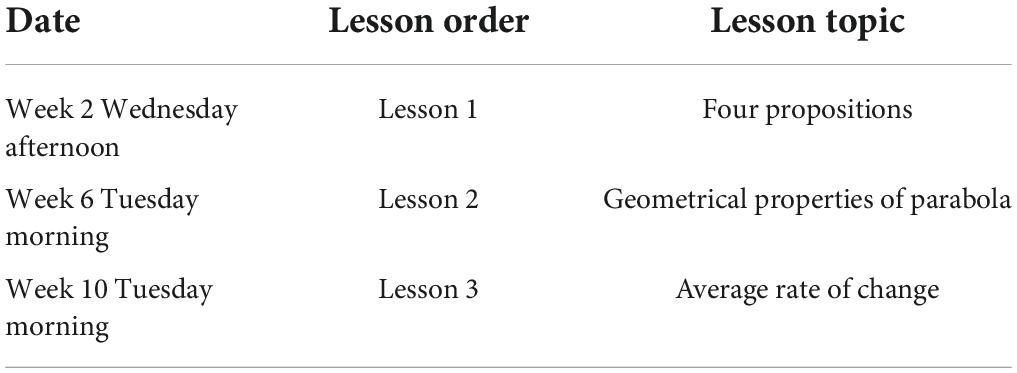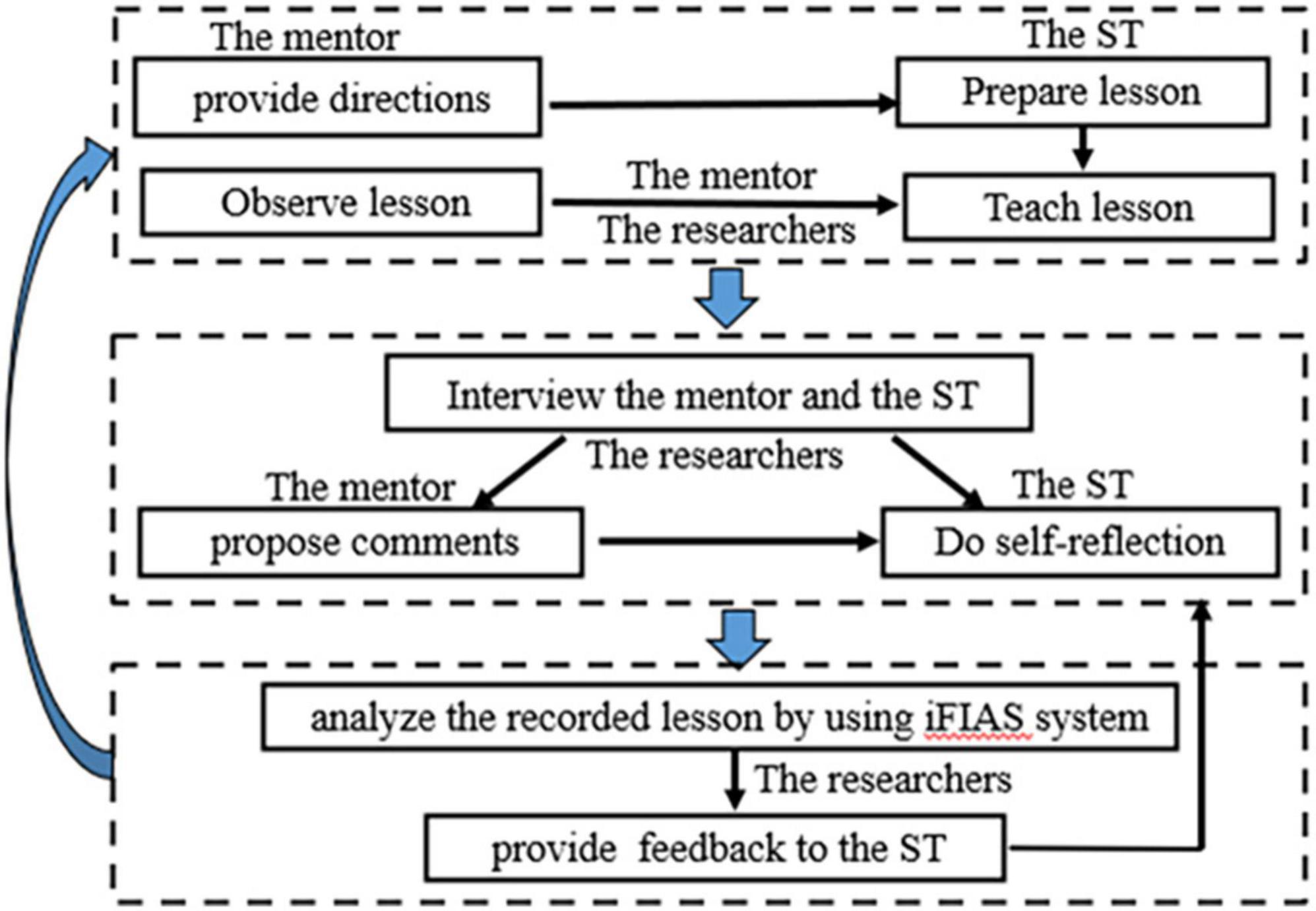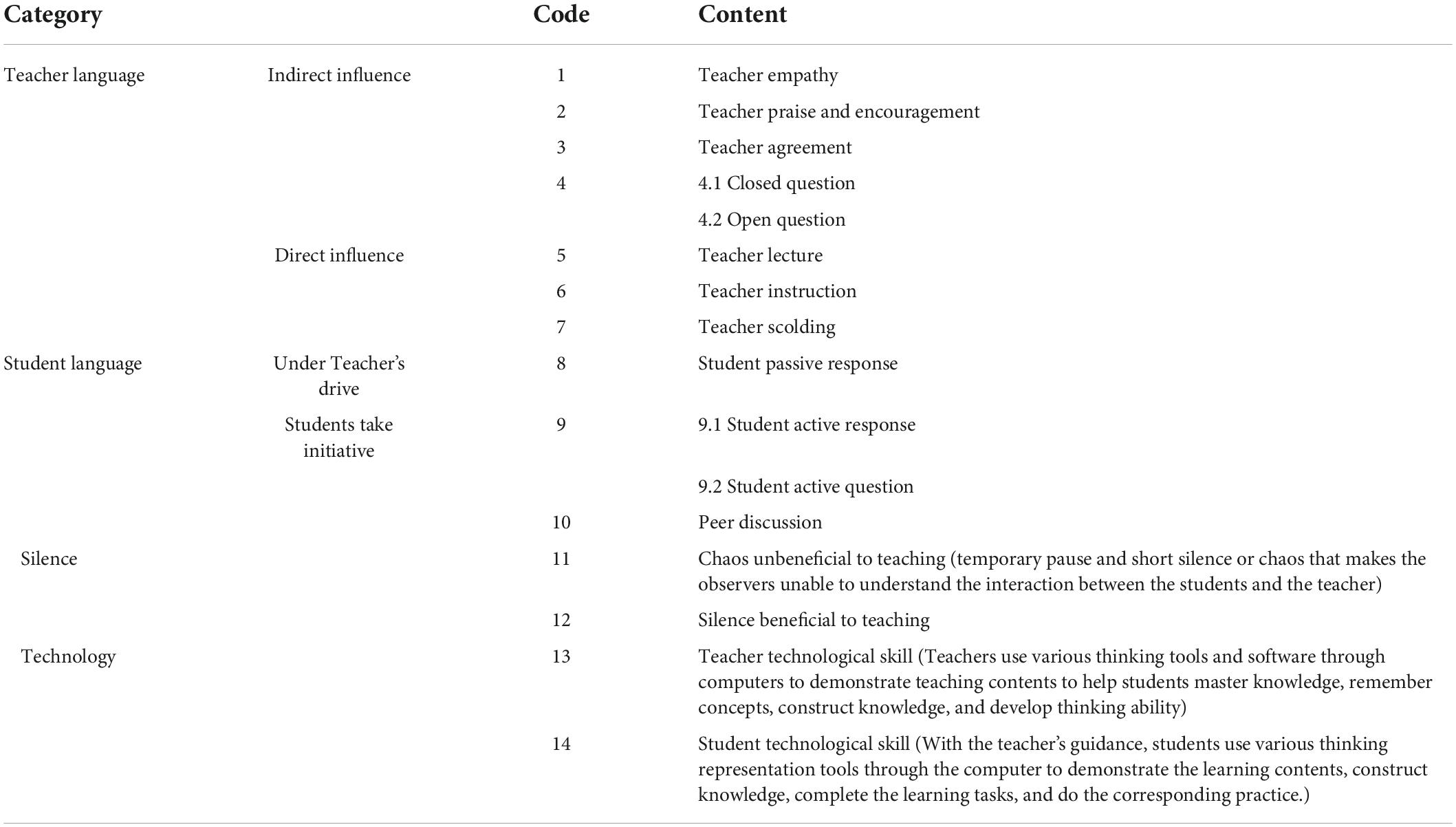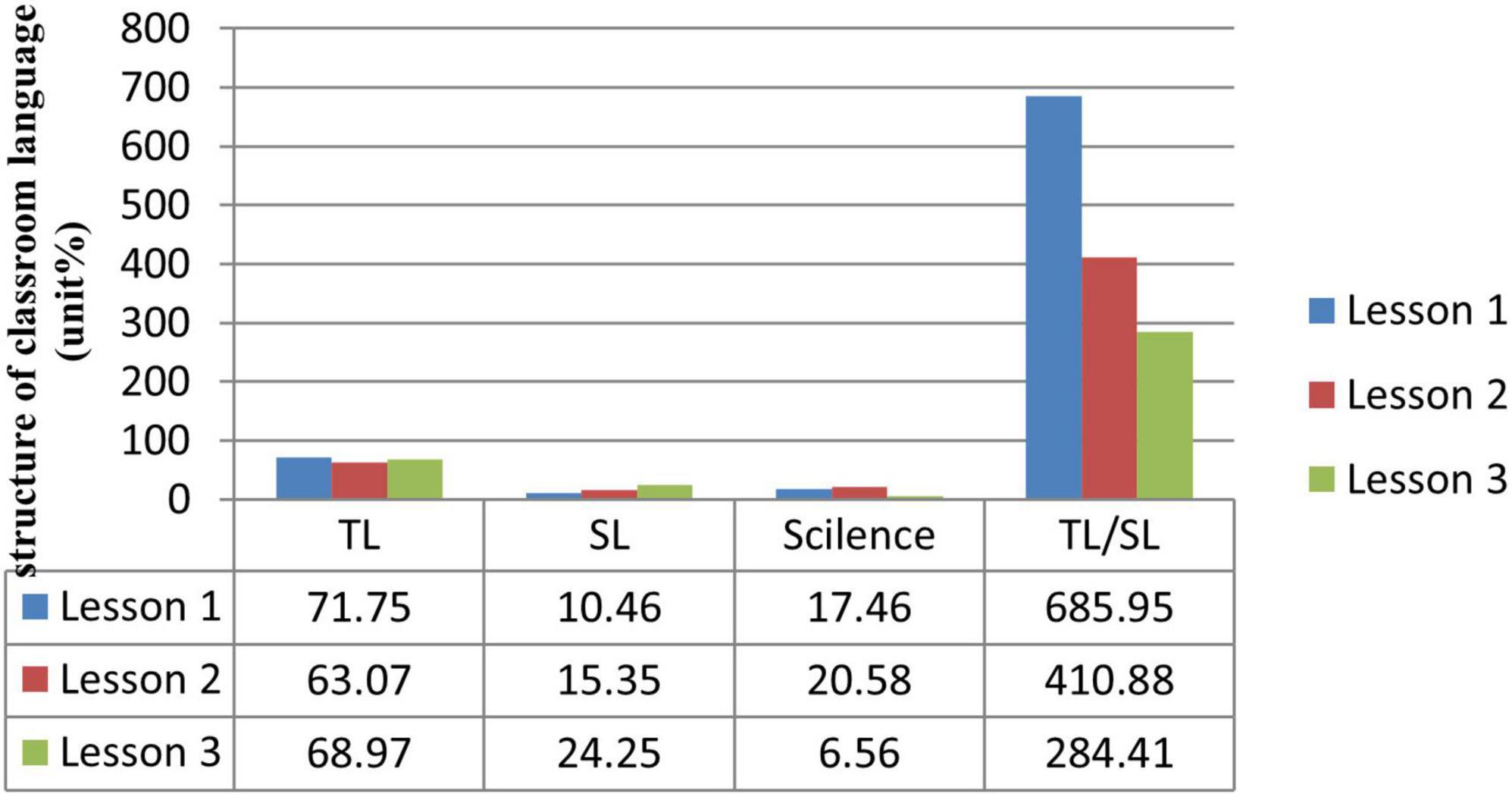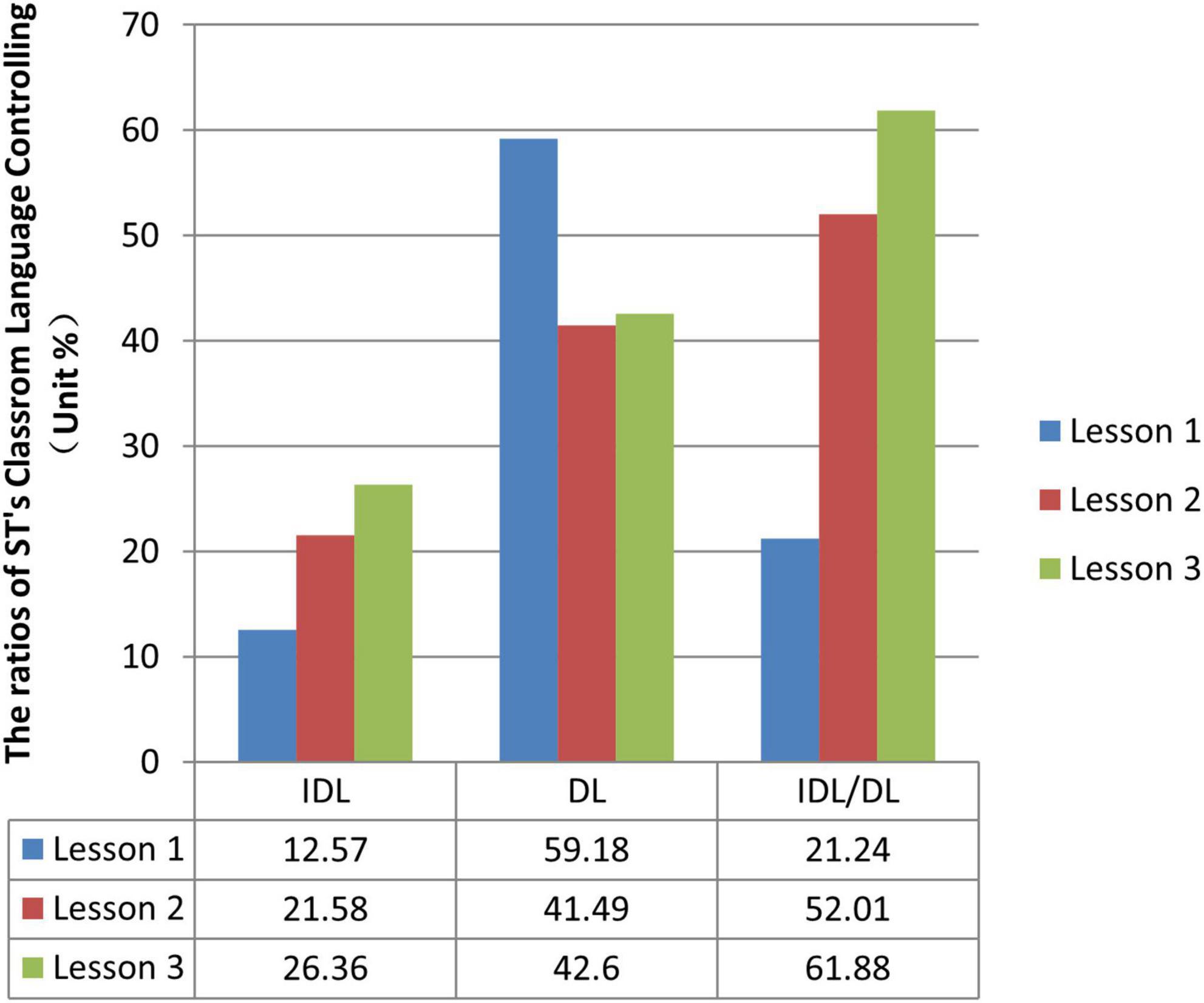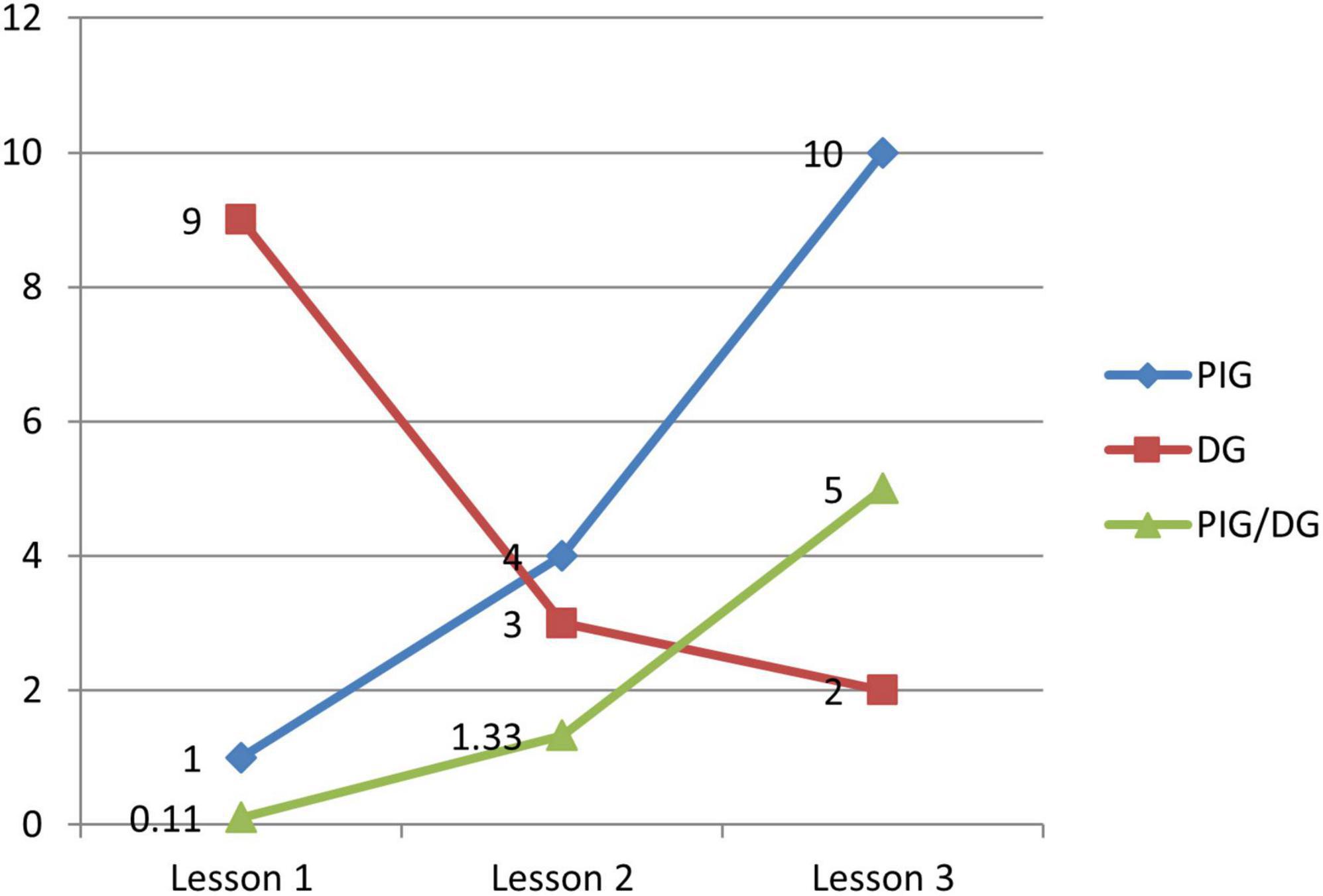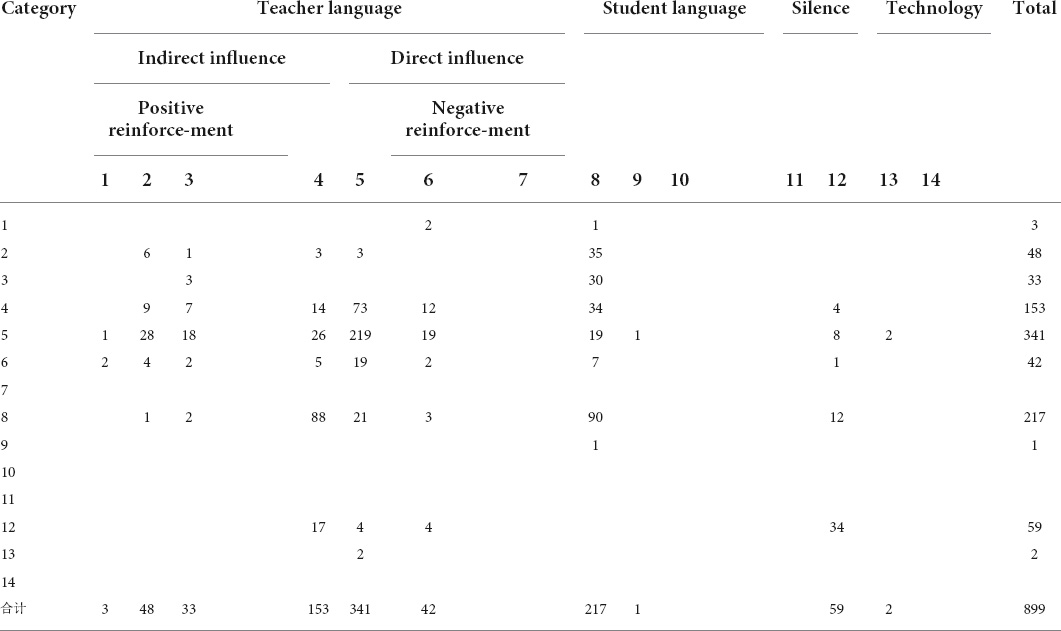- 1College of Mathematical Science, Yangzhou University, Yangzhou, Jiangsu, China
- 2College of Foreign Language, Zhejiang Ocean University, Zhoushan, Zhejiang, China
- 3Xin’an Primary School, Huai’an, China
This case study aimed to investigate the changes in student teachers’ (STs) interactional language during their internship at local schools. The student teacher interactive language was measured using the analytical tool of improved Flanders interactive analysis system (iFIAS), and an intervention and interview were conducted afterward. The study found that the student teacher’s interactive language keeps changing: the ratio of teacher language (TL) is increasing, while the ratio of student language (SL) and silence are decreasing; the teacher’s direct instruction gradually shifts to indirect instruction; the number of positive integration grids (PIG) grows larger, while the number of defect grids is getting smaller; and the teacher asks more valid questions and makes more positive comments. The overall change did not come naturally, but due to the mentor’s instruction, the ST’s self-reflection, and the researchers’ prompt feedback of the iFIAS after each lesson. The study quantified the ST’s classroom language using iFIAS to provide a visualized understanding of the language. The findings can provide a reference value for future research on the interactive language of student teachers.
Introduction
The interactive language of mathematics classroom refers to the language describing the patterns and traits of oral interactions between teachers and students (Li, 2013). The interactive language is an indispensable part of mathematics teaching. During teaching, the participants communicate, cooperate, and hold dialogue. The interaction includes the teacher supporting students’ learning to elicit more learning activities and students providing feedback to urge the teacher to adjust learning activities to realize the teaching objectives (Sun, 2008).
The Chinese Mathematics Curriculum Standards for G1–G9 (CMCS) prescribe that teachers should encourage students to actively participate in teaching activities, take initiative to ask questions, analyze problems, think independently, and cooperate with others; teachers should guide students to think from different angles, express their thinking in a structured way, listen and understand others’ ideas, and reflect on their thinking process (Ministry of Education of the People’s Republic of China, 2011). Currently, scholars around the world have conducted in-depth research on the features of mathematics teachers, such as excellent teaching characteristics (Zhang, 2016), professional knowledge, and comparison of teaching languages of different teachers (Liu, 2017). In essence, mathematics classroom teaching is a process of constructing new knowledge through the interaction between teachers and students. However, the lack of teaching experience, especially the lack of the understanding of students’ needs and the lack of capability in coping with the complex classroom environment, make student teachers inadequate to have effective interaction with students (Hao et al., 2017).
Literature review
Appraisal system
This study is informed by the methodological framework of Martin and White’s (2005) appraisal system. The system analyzes the semantic aspect of the language the speakers use and explores the attitudes expressed by the speakers. The appraisal framework includes three interactive components: attitude, engagement, and graduation (Martin and Plum, 1997; Martin and Rose, 2003; Martin and White, 2005). The researchers in this study focused on the domains of attitude and engagement to illustrate how the student teacher (ST) used language to express appreciation or acknowledgment and to engage students with effective interactive discourses. Attitude is concerned with feelings of emotional reactions to what happens, assessing behavior based on certain principles and appreciation of the values of things (Martin and White, 2005). Engagement analysis deals with the play of other voices around the speaker’s discourse and investigates “the degree to which speakers/writers acknowledge this prior speaking whether they present themselves as standing with, as standing against, as undecided, or as neutral with respect to these other speakers and their value positions” (Martin and White, 2005, p. 93). There are two main classifications, “monogloss” and “heterogloss,” in an engagement system. Monogloss seeks no reference to other voices and viewpoints. The speakers present themselves as a single voice, preferring to give facts rather than negotiate the meanings. Less engagement happens and no dialogistic alternatives are recognized. On the other hand, heterogloss is inherently dialogue-oriented. The heteroglossic voice seeks to engage the audience using a variety of language and allows room for referencing other voices or recognizing alternative positions (Martin and White, 2005). Simply speaking, the two components of appraisal system inform whether teacher language (TL) has an emotional influence on student engagement with positive attitudes and provokes active teacher-student interactions with heteroglossic voice.
Teacher language can shape students’ learning when they are properly designed to engage students in classroom interaction (Mesa and Chang, 2010). This study collected and interpreted the data of the student teacher’s classroom language in three teaching fragments captured from three lessons of different stages to examine the attitude their language reflected and the engagement force of the language.
Formative feedback
Formative feedback is a strategy of providing suggestions and directions to scaffold learners’ learning and, theoretically, it is more effective than standard modes of feedback (Cobbold and Wright, 2021). A growing body of research demonstrates that the effectiveness of formative feedback on student assessments contributes to higher educational progression (Nicol and Macfarlane-Dick, 2006; Hattie and Timperley, 2007). Despite much empirical demonstration, what well-designed formative feedback can achieve in practice still needs to be investigated (Jackel et al., 2017).
In this study, through formative feedback the researchers pointed out the direction of improvement for the ST after analyzing the ST’s interaction performance in each observed class. This led the ST to carry out self-reflection and think about how to adapt and improve their interaction ability.
Self -reflection
As teachers are applying teaching strategies, they not only need to consider the content, but also the students they teach. Sometimes, a special teaching environment may influence the effect, so teachers need to reflect on their teaching after each lesson. Reflection functions like a mechanism for the improvement and development of teaching (McAlpine and Weston, 2000). The teachers need to consider how to reconstruct the professional knowledge and beliefs combining the pre-existing and the new; they need to consider what their future needs are and how to acquire the needs; and they need to explore how to integrate the professional learning into their classroom teaching. Reflection in, on, and about practice is essential to building, maintaining, and further developing the capacities of teachers to think and act professionally over the span of their careers (Day, 1999).
In this study, the ST who participated in the study carried out self-reflection on their interactive language after each of the observed lessons. The prerequisite of doing self-reflection is that the ST had a strong desire to improve their classroom interaction competence.
The timely feedback from researchers and mentors on the interaction performance of student teachers’ (STs) can help STs to understand the specific problems in their classroom interactive language such as language structure and style, emotional communication, and questioning techniques in the classroom, which will conduce more directional and pertinent self-reflection of STs. More specifically, STs reflect on how to improve their classroom interaction in the follow-up classroom, thus enhancing the students’ participation and enthusiasm, resulting in better teaching effect.
Mathematics classroom language
The role of language in teaching and learning mathematics has been studied since the 1980s (e.g., Pimm, 1987; Cocking and Mestre, 1988; Adams, 2003). Many studies have reinforced the claim that language plays a critical role in mathematics teaching (e.g., Reeves and Bickmore-Brand, 1990; MacGregor and Price, 1999). It has become common knowledge that language and mathematics are closely connected, and this has been consistently addressed in math research (de Oliveira and Cheng, 2011). Language factors have long been recognized as having an important influence on mathematics learning (Ellerton and Clarkson, 1996). In mathematics education, the importance of verbal communication has also been extensively explored, and it is considered one of the essential processes in improving understanding (MacGregor and Price, 1999; Warfiel, 2003). The ability to communicate mathematically is central to learning and teaching mathematics (Setati, 2005).
Mathematics classrooms are traditionally set as a place where teacher lecturing dominates the interaction between teachers and students (Lutzer et al., 2007). It seems a difficult task to increase student participation in mathematics classrooms. Notably, attending to language is one of the main ways the teacher can change the dynamic interaction of mathematics classrooms (Mesa and Chang, 2010). Pedagogical discourse in mathematics classrooms is composed of spoken language and written language, and spoken language is used to contextualize the mathematical concepts to enhance student understanding (O’Halloran, 2015). Clarke and Xu (2010) find that teachers’ proper questioning and frequent prompts can help students to orally recall prior knowledge and construct new knowledge. Therefore, teacher interactive language on class deserves great emphasis, even from the internship stage.
Student teachers’ classroom language in China
Student teachers’ classroom language skills include introduction skills, explanation skills, presentation skills, questioning skills, and feedback skills, which are among the teaching skills that STs are trained to acquire (He, 2014). The Ministry of Education of the People’s Republic of China (2011) issued the “Teacher Education Curriculum Standards (Trial),” which requires that the courses and training in teacher universities focus on strengthening practical awareness and developing practical abilities. Many education universities have implemented reforms in teacher education courses and attached great importance to STs’ practical teaching skills. However, there is still a large gap between the teaching skills of STs and the requirements of basic education practice (Hao et al., 2017). Regarding STs classroom language, Hao et al. (2017) find that STs dominate the class and have little interaction with students, leaving limited space for students to reflect and participate. This finding is in line with the result of the study by Liu (2013), who finds STs lack the skill to help every student effectively to participate in learning activities. STs’ classrooms are usually teacher-led and dominated by one-way teacher-student interaction. Furthermore, STs’ incompetence is also manifested in the inaccuracy of language and the directionality of questioning, which affect students’ understanding of the knowledge and the validity of the question (Huang et al., 2013).
Researchers have investigated the problems of STs’ classroom language from different perspectives, but few have delved into in-depth and comprehensive analysis of individual cases. It is also rare to find research in the literature that explores the interactive language of a specific ST and the external factors that influence their performance during the whole internship. Therefore, it is necessary to delve into the specific problems existing in STs’ classroom language, so as to take corresponding measures to improve STs’ teaching skills.
The current study is intended to find out: (1) What are the characteristics of the ST’s classroom language in the mathematics classroom in China? and (2) What are the influential factors that drive the ST’s change?
Materials and methods
Setting
This study was conducted in high school A, which is located in the downtown Y city, China. This school is an internship base for student teachers from Y University. Normally, the internship lasts for 12 weeks, during which STs are required to observe their mentor’s teaching, help the mentors manage students’ study, and teach three or more lessons under the guidance of the mentor during the internship.
Participants
In this study, there were three types of participants: the ST, the mentor, and Class 4 of Grade 11. The ST was the main subject investigated in this study. The participant ST was recruited from 12 second-year students studying for a master’s degree in mathematics education at Y University in China. They would be assigned to different high schools for a 3-month internship. After dispatching the information sheet, five students responded to the invitation. The researchers then conducted a one-on-one interview and selected one student who met all the requirements and had a strong desire to cooperate. As a postgraduate student, she had a good background of mathematics and pedagogy knowledge, but she did not have much experience in teaching in real classroom settings. She aspired to become an outstanding teacher, and she voluntarily offered to participate in this study in order to enhance her teaching skills, especially in handling classroom language. The mentor has more than 20 years of experience in teaching high school mathematics. He provided all resources that the ST needed when preparing the practice lessons. Class 4 was one of the mentor’s classes, in which the students were about 16–17 years in age and composed of 24 boys and 27 girls. In China, the normal size of class in high school is about 45–55 students, hence, the participated class is a regular size.
After obtaining permission to implement this research at school A from the Y city Education Bureau, the informed consent form for participating in this study was sent to the ST, the mentor, and the students in Class 4 of Grade 11. All participants including the students’ parents knew what would be involved in the study. They agreed to participate in the study.
Research design
The study adopted the case study method to closely examine the data concerning the ST’s language in class. A case study intensively explores and investigates a real-life phenomenon observed in a small geographical area or happening to an individual unit through detailed contextual analysis (Zainal, 2007; Yin, 2017). Therefore, this study focused on the particularity and complexity of the case of a mathematics ST, understanding the development of the ST’s interactive language during her internship. Both quantitative and qualitative methods were employed to capture the complexity of the case.
In this study, the ST conducted three lessons at different stages of her internship. The topics of the three lectures were not purposefully chosen by the ST. They were scheduled depending on the school calendar and the contents intended to be taught according to the semester teaching plan (see Table 1).
The research process of the case is described in Figure 1. Before each lesson, the ST prepared the lessons with the guidance of the mentor, including writing a lesson plan and designing a Power Point or a dynamic graph if needed by using a geometry sketchpad (GSP). The mentor and the researchers jointly observed the ST’s teaching. After each lesson, the researchers interviewed the mentor for her comments and interviewed the ST on her self-reflection and self-assessment. After the researchers analyzed the recorded lesson by using improved Flanders interactive analysis system (iFIAS) system, the results would also be directed to the ST.
The researchers recorded the three lessons and encoded the videos using iFIAS to quantify and visualize the ST’s interactive language structure. Regarding the interviews, the researchers designed different interview outlines (see Appendix 1) for different lessons in order to obtain useful information that reflected the ST’s progress in using interactive classroom language.
Research tool
The study employed the iFIAS supporting digital classroom. The main steps of iFIAS analysis include creating a record table of classroom observation, building a matrix, and data analyzing the output. First, the videos of the teaching were transcribed into text. Every 3 s of text formed a node. Second, the text in the 3 s was interpreted and analyzed, and then they were translated into codes using the iFIAS Coding System as shown in Table 2.
Findings
Characteristics of the student teacher’s classroom language
This section was devoted to interpreting the output of iFIAS coding to show the characteristics of the ST’s language. The interpretation covered the following aspects.
Structure of classroom language
In a mathematics classroom, the ratio of teacher language (TL), student language (SL), and silence to the whole class reflects the roles of teachers and students in the classroom. The ratio of the sum of 1–7 encoding times to the total encoding times makes the ratio of teacher language; the ratio of student language equals the ratio of the sum of 8–10 encoding times to the total encoding times; the ratio of the sum of 11–12 encoding times to the total encoding times forms the ratio of silence. The higher the ratio of the TL indicated that the teacher spoke more in the classroom. The norm for TL was about 68% (Wang, 2014).
Figure 2 showed that the ratio of TL in the first lesson was 71.75%, which was higher than the norm. The ratio was 63.07% in the second lesson, lower than the norm, and 68.97% in the third lesson, close to the norm. The ratio of TL tended to decrease, which indicated that the ST’s teaching gradually changed from “teacher-centered” to “student-centered.” The norm of SL was about 20%. The ratios of SL to the whole class were 10.46, 15.35, and 24.25%, respectively, at the three lessons, which showed an increasing tendency. The ST’s interaction with students in the later stages of the internship increased, so students had more opportunities to speak. Against the norm (11 or 12%), the ratios of silence in the three lessons (17.46, 20.58, and 6.56%, respectively) displayed a curve line but declined significantly in the third lesson, which indicated that teacher-student interaction was increasing as ST’s experience built up. The ratios of TL to SL at the three lessons were 685.95, 410.88, and 284.41%, respectively, which demonstrated a declining trend, indicating that the teacher spoke gradually less, and the students had more opportunities to speak.
Influence of teacher language
The ratio of direct language (DL) and indirect language (IDL) of the teacher in the classroom reflected the teacher’s language orientation and style. The sum of 1–4 encoding times to the total encoding times made the ratio of IDL, and the sum of 5–7 encoding times formed the ratio of DL.
Figure 3 imaged the ratios of teacher IDL at the three lessons (12.7, 21.58, and 26.36%) displayed an increasing trend. The teacher gradually learned to promote students’ learning by commending, encouraging, and showing empathy. The ratios of teacher DL at the three lessons (59.18, 41.49, and 42.6%) showed a declining trend, indicating that the teacher gradually reduced instructional teaching such as lecturing and whole-class instruction. The ratios of IDL to DL at the three lessons were 21.24, 52.01, and 61.88%, respectively, which showed a rising trend. The trend demonstrated that the teacher’s language style in the classroom gradually shifted from direct instruction and lecture to negotiating meaning with students to complete teaching.
Emotional communication of student teacher with student
In classroom teaching, the number of positive integration grids (PIG) and defect grids represent the degree of emotional communication between teachers and students. The positive integration grid refers to the area enclosed by 1–3 columns and 1–3 rows in the matrix (see Appendixes 2–4). The defect grid (DG) refers to the area enclosed by 6–7 columns and 6–7 rows in the matrix. The larger the number of PIG, the more harmonious the relationship between teachers and students, while a larger number of defect grids indicates a more difficult relationship (Wu et al., 1991).
According to Figure 4, the number of PIG kept increasing from one in the first lesson to 10 in the third lesson, and the number of defect grids were getting smaller from nine in the first lesson to two in the third lesson. The ratios of the PIG to the DG over the three lessons increased from 0.11 to 5. The ratio of the second class (1.33) and the ratio of the third class (5) were both greater than one. The results indicated that the relationships between the teacher and the students were getting closer and more amicable. The results were evidently influenced by the change of the teacher’s classroom language. With an increase of the teacher’s praise, encouragement, and empathy and a decrease of the teacher’s instructional and disciplinary language, teacher-student interaction became more active, and their relationships became more harmonious.
Changes and problems identified from the micro-analysis of teaching fragments
In order to identify the changes and problems of the ST’s interaction language, it is necessary to capture some teaching fragments to carry out micro-analysis. In this study, three teaching fragments were captured from three lectures by the ST at different stages. An appraisal system was used as a framework for directing the analysis. Throughout the three teaching fragments, the ST made some progress in expressing attitude and engaging students, especially in emotional reaction and questioning. However, it was still difficult for her to lead students to conduct deep thinking. She lacked the skills to effectively enlighten students’ critical thinking.
Problems identified from the teaching fragment of lesson 1
The topic of lesson 1 was “Four Propositions.” The main learning objective of this lecture was to understand the concept of proposition, the four types of a proposition, and the relationships among the four types. The teaching fragment is displayed as follows:
ST: Please write down the other three types of the following propositions and determine whether they are true and false.
(Several minutes later).
ST: Hong, you first.
Hong: The converse proposition of the first one is: If x belongs to A and B, then x belongs to A.
ST: Is it true or false according to your analysis?
Hong: True.
The other students (in chorus): False.
ST: Hong, true or false?
Hong: False.
ST: Yes, it is false. …… (Then, the ST demonstrates writing format on the blackboard) This is false, and what about the negative proposition.
Hong: If x does not belong to A, then x does not belong to A and B.
ST: Is it true or false?
Hong: False.
ST: (Write down on the blackboard) What about the converse negative proposition?
Hong: If x does not belong to A and B, then x does not belong to A.
ST: Is it true or false?
Hong: True.
ST: Yeah, very good.
In the dialogue, the ST only focused on one single student, neglecting other students’ responses. She should follow up with “why” after other students to elicit an explanation to help Hong understand why the converse proposition is not true. Additionally, the ST’s language is indecisive and repetitive. Most of her questions focused on whether the propositions are true or false, which cannot exploit the students’ thinking process. The ST did not specifically acknowledge students’ response, apart from a general praise “very good.” She did not recognize that knowing how students think is more important than knowing what results the students get. She initiated the dialogue only to get her expected right answer, not to encourage thinking. In summary, the dialogue is heterogloss in form, but it is monogloss in essence.
Changes and problems identified from the teaching fragment of lesson 2
The topic of lesson 2 was “Geometrical Properties of Parabola.” The main learning objective of this lecture is exploring the geometrical properties of parabola through observing some concrete examples, and then understanding and grasping the properties to solve related mathematics problems.
……
ST: First, what do we find according to the image of a parabola?
S1: The image is located in the half of coordinate plane.
ST: Well. Additionally, the parabola curve can extend infinitely, but does a parabola have asymptote?
Some students: No.
Some of the other students: Yes.
ST: According to the study of the image before, yes or no?
All the students (in unison): No.
ST: Great, it has no asymptote.
ST: Think again. How many axes of symmetry does a parabola have?
All the students (in unison): One.
ST: Is there a symmetric center?
All students: No.
ST: Is it the same as the properties of an Ellipse and hyperbola?
All the students (in unison): No.
ST: Let us take this thinking further. How many vertices and focal points does a parabola have, and how many other directrix? You respond to this (She pointed to S2).
S2: There is only one vertex, one focal point, and one directrix.
ST: Is his answer right?
All the students (in unison): Yes.
ST: Please sit down.
ST: Please continue to think. What effect does the parameter P in the parabolic standard equation have on the parabolic opening?
The dialogue above showed that ST could conduct both individual and whole-class interaction, indicating she made efforts to engage more students. Obviously, she made some progress in leading the interaction. The dialogue is heterogloss in form, and also in essence to a certain extent. However, she asked more closed questions than open questions. For example, she did not challenge students for an explanation for “yes” or “no.”
Changes and problems identified from the teaching fragment of lesson 3
The topic of lesson 3 was “Average Rate of Change.” The main learning objective was understanding the concept of average rate of change, connecting this concept with problems of steepness in real life, and understand the concept of slope. One teaching fragment was displayed below.
……
ST: Here, what is the point A represents?
All the students (in unison): The highest temperature of that day.
ST: Great, what about point B.
All the students (in unison): The highest temperature of the day April 20th.
ST: Please think about the steepness of the curve of AB and BC, which one is steeper?
All the students (in unison): BC.
ST: Wonderful, you all found out very quickly. So, what kind of quantity do we choose to describe the steepness of the curve?
ST: (silent) We have learned the knowledge of straight lines before. How did we express the inclination of a straight line?
ST: May Wang answer this question? (She pointed to a boy sat in the back).
Wang: Slope.
ST: Right. Very good. We use slope to reflect on the inclination of a straight line.
ST: Can we also use slope to describe the steepness of the curve?
All the students (in unison): Yeah.
ST: Now we use the ratio of to approximately describe the skewness of this curve.
In the above dialogue, the ST tried to guide students to construct new knowledge of describing the skewness of a curve by using analogy. She designed a series of interrelated questions to scaffold students exploring the knowledge. She promptly appreciated and acknowledged the students’ responses. Compared with the previous two lesson fragments, the ST’s interactive ability was enhanced, although she still had problems in guiding students to conduct higher-order thinking.
Problems and changes identified in the student teachers language from the analysis of interview data
After each lesson, the ST and her mentor were interviewed. Both were invited to reflect on the student teacher’s classroom language such as instructions, questions, and comments. Moreover, the teachers were encouraged to express their ideas on how to address the problems.
Problems and changes in instruction
Overall, the interview data showed that the instructional language of the ST was constantly improving, although problems are still visible. The following table (Table 3) showed the problems and changes existing in the ST’s instructional language.
Problems and changes in questioning
The interview revealed that the ST only did simple questioning at the beginning, and later consciously raised some referential questions like “Why” or “How,” but there was still room to improve in terms of questioning strategies. The following excerpts showed the problems and the development of the teacher’s questioning skills (see Table 4).
Problems and changes in teacher comments
The interview data revealed that the ST made progress in her comment language throughout the internship, from not knowing how to make comments or making dull comments to making targeted comments. However, there were still some problems such as lack of encouragement and praise. The following excerpts displayed the problems and the development of the teacher’s commentary language (see Table 5).
Discussion
This study analyzed the interactive language of a mathematics ST from both quantitative and qualitative perspectives. According to Yin (2014), case study research is conducted and examined in a real context. Moreover, the case selected is pertinent to the research purpose and related to the theoretical proposition of the proposed research topic. The current case study was investigated in a real classroom and the case was selected to achieve our purpose of understanding STs’ teaching language. An appraisal System underpinned the interpretation of the findings about the ST’s interactive language in class. Formative feedback was a scaffold that helped the ST reflect on her interactive language. Self-reflection was the important internal impetus mechanism to promote the ST’s professional development of classroom interaction.
The quantitative and qualitative data showed that the ST’s interactive language was constantly improving. The result is similar to many previous studies, which showed that internship programs can really refine and improve STs teaching skills in an actual school setting (e.g., Rhoads et al., 2011; Parveen and Mirza, 2012; Tindowen et al., 2019). In the latter stage of the internship, although her teaching language was still not refined enough, she was able to express herself clearly and naturally. She displayed an increasing positive attitude and more powerful engagement force in her teaching language, which are two important components of the appraisal system. Specifically, the ST made progress in questioning skills, both in the amount of the questions and the quality of the questions. Teachers’ valid questions engage students by inducing dialogue between the teacher and students or between the students. An appraisal system affirms the effective way of engaging students by dialogue-oriented heteroglossia. Furthermore, two kinds of data indicated that the ST improved in her comment skill gradually. The quantitative data show that the positive comments and pleasant relationships promoted interaction between the teacher and the students.
In the harmonious relationship, the teacher’s instructional and disciplinary language was gradually decreasing as Figure 4 showed. Attitude, the interactive component of the appraisal system, suggests teachers’ positive reaction to students’ response promotes students’ engagement. The qualitative analysis indicated that, at the later stage, the ST was able to make specific comments based on the teaching focus and students’ responses, although there was still room for improvement.
The progress of the ST’s teaching language towards interactive did not come naturally, but came due to the instruction of the mentor, the ST’s self-reflection, the researchers’ feedback of the iFIAS of each lesson, and repeated practice. These influential factors had been manifested to be beneficial to STs’ growth in previous research such as Al-Issa and Al-Bulushi (2010), Rhoads et al. (2011), Caires et al. (2012), Faikhamta and Clarke (2019), and Lopes Santos and Nunes da Silva (2020). The ST reported that she observed many videos of teaching and read books about TL. She observed her mentor’s lessons and practiced the techniques learned with other student teachers by observing each other. Careful preparation and repeated practice helped fluency and natural expression. The mentor highly recommended observing other experienced teachers teaching the same lesson, adjusting and practicing the techniques in time, and then teaching it to her own class as soon as possible. The mentor also reinforced the importance of preparation, either in respect of the teaching content or personal language training. Additionally, the researchers presented their analysis results of each lesson to the ST, which helped the ST identify the problems of her classroom language and do effective and deep self-reflection.
Teacher questions were highlighted as an important prompt for interaction. The ST said, under the mentor’s guide, she learned to ask standardized and specific questions on the knowledge to be taught and prepared carefully beforehand. The preparation included not only preparing the questions but also presuming how the students would answer and how she would respond. When posing questions, the teacher should consider where students are sitting as well as students’ academic level. The mentor emphasized the importance of question designs, which should be composed of a string of questions connecting the teaching contents. Therefore, preparing every question before class was essential.
Teacher comments in class are one of the important components of teacher verbal language (Gillies, 2006; Gillies and Boyle, 2008). The ST said that even comments with simple language required practice to be natural and meaningful. She observed experienced teachers on how to make proper comments at the proper time and she practiced with other internship teachers.
The findings provided implications for STs’ education and internship:
(1) Highlighting the importance of mentors intervene. For example, after each lesson, the mentor should comment on the performance of the student teacher in a targeted manner and propose corresponding improvement strategies. In class, the student teacher might make mistakes, fail to make comprehensive connections, or lack diversified interactive language. The mentor should record any inadequacies of the interactive language of the ST when observing. After class, the mentor should propose specific improvement suggestions for these problems. It is a mentor’s responsibility to provide or recommend resources such as opportunities of observing other lessons, or APPs and books. Research shows that mentors play multiple roles and mentorship is a powerful instrument that improves STs’ practical capabilities (e.g., Manathunga, 2007). Faikhamta and Clarke (2019) highlight that the mentors play a vital role in educating STs during their internship because mentors strongly influence STs in terms of “what to teach,” “how to teach,” and “why to teach.”
(2) Conducting self-reflection in a timely manner. As the main participant and organizer of classroom teaching activities, the ST has a deeper understanding of his/her own interactive language in the classroom. After class, the ST should reflect on the problems that appear in class and discuss these reflections with the mentor in time. According to the teacher growth formula proposed by the famous American educational psychologist Posner (1989): Growth = experience + reflection. Reflection enables STs to diagnose and understand their classroom contexts and students’ learning better and critically identify the deficiencies of their teaching and address them to result in improved future classroom encounters (Al-Issa and Al-Bulushi, 2010; Minott, 2011). Globally, encouraging reflective teaching and self-questioning is a central theme in STs’ school-based training process (Donche et al., 2015).
(3) Preparing themselves adequately. The preparation includes reading extensively to gain a pedagogical understanding about target teaching, observing as many lessons as possible, and practicing specific skills with peer STs. Throughout the internship, a ST is usually allowed to teach a few lessons, so preparation is crucial to enhancing the value of the few lessons. Creating the teaching plan carefully based on established knowledge from reading and observing, conducting the lesson and reflecting on the teaching afterwards, and addressing the problems identified in the teaching before teaching again are important steps for improved teaching. The STs who tend to carry out self-reflection and full preparation are to a certain extent in line with the independent meaning-oriented STs that Kyndt et al. (2014) defined. The STs with this orientation are more likely to improve their teaching skills by developing their knowledge base, interacting with their mentors, and learning from the problems they have encountered (Donche et al., 2015).
Case studies are deemed to be contextual to an individual. However, the ST’s active interaction with the instructor and self-reflection based on the instructor’s feedback has a positive reference for the professional improvement of STs. The findings helped STs and mentors to formalize a better understanding of how to make the internship effective. Educators in the field of teacher education are inspired to organize effective and practical courses and programs for pre-service teachers and the practice of internship. In future studies, the samples can be expanded, and STs with different study and professional backgrounds could be selected to examine the changes in their classroom interaction during the internship.
Conclusion
The study aimed to investigate STs’ interactive language and how they improve it with external support and self-regulated study. By utilizing iFIAS, the current case study examined the ratio of teacher talk against student talk, the ratio of direct instruction of teacher against the indirect instruction of teacher, and the ratio of positive interaction of a teacher against negative interaction of a teacher. The results indicated that STs made progress gradually. The interview of the ST and her mentor suggested that various efforts by the ST and the guidance of the mentor resulted in the improvement. The implications for the internship also informed STs’ education programs in teacher universities before and after their internship. Obviously, the study has its limitations. Its generalizability and validity may be questioned as any case study is often criticized (Johansson, 2003; Stewart, 2014; Merriam and Tisdell, 2015). However, this study was trying to strengthen the methodological quality by merging qualitative case study research with quantitative methods of data analysis (Yin, 2014).
Data availability statement
The raw data supporting the conclusions of this article will be made available by the authors, without undue reservation.
Ethics statement
The studies involving human participants were reviewed and approved by Ethics Committee of Yangzhou University. Written informed consent for participation was not required for this study in accordance with the national legislation and the institutional requirements.
Author contributions
SC and HL cooperated to start the project and completed the project design, discussed and developed the framework of the article, and did all the review work together. SC and JC collected the data in Chinese. HL did the transcription and composed the draft. JC also contributed some ideas to the development of the article. All authors contributed to the article and approved the submitted version.
Funding
This project was funded by the Grant of Graduate Research and Innovation Projects of Jiangsu Province (CN) (numbered with JGLX18_058). And also funded by the Grant of Graduate Education Reform and Practice Projects of Yangzhou University in 2021 (numbered with JGLX2021_008).
Conflict of interest
The authors declare that the research was conducted in the absence of any commercial or financial relationships that could be construed as a potential conflict of interest.
Publisher’s note
All claims expressed in this article are solely those of the authors and do not necessarily represent those of their affiliated organizations, or those of the publisher, the editors and the reviewers. Any product that may be evaluated in this article, or claim that may be made by its manufacturer, is not guaranteed or endorsed by the publisher.
References
Al-Issa, A., and Al-Bulushi, A. (2010). Training English language student teachers to become reflective teachers. Aust. J. Teach. Educ. 35, 41–64. doi: 10.14221/ajte.2010v35n4.4
Caires, S., Almeida, L., and Vieira, D. (2012). Becoming a teacher: Student teachers’ experiences and perceptions about teaching practice. Eur. J. Teach. Educ. 35, 163–178. doi: 10.1080/02619768.2011.643395
Clarke, D., and Xu, L. (2010). “Spoken mathematics as a distinguishing characteristics of mathematics classrooms in different countries,” in Proceedings of the sixth congress of the European society for research in mathematics education 2009: CERME 6, eds D.-G. Viviane, S.-L. Sophie, and A. Ferdinando (Lyon: Institute National de la Recherche Pedagogique (INRP)), 2463–2472.
Cobbold, C., and Wright, L. (2021). Use of formative feedback to enhance summative performance. Anatol. J. Educ. 6, 109–116. doi: 10.29333/aje.2021.619a
Cocking, R. R., and Mestre, J. P. (1988). Linguistic and cultural influences on learning mathematics. New Jersey, NJ: Lawrence Erlbaum Associates.
Day, C. (1999). Professional development and reflective practice: Purposes, processes and partnerships. Pedag. Cult. Soc. 7, 221–223. doi: 10.1080/14681366.1999.11090864
de Oliveira, L. C., and Cheng, D. (2011). Language and the multisemiotic nature of mathematics. Read. Matrix Int. Online J. 11, 255–268.
Donche, V., Endedijk, M. D., and Van Daal, T. (2015). Differential effects of a long teacher training internship on students’ learning-to-teach patterns. Eur. J. Teach. Educ. 38, 484–495. doi: 10.1080/02619768.2015.1057562
Ellerton, N. F., and Clarkson, P. C. (1996). “Language factors in mathematics teaching and learning,” in International handbook of mathematics education, eds A. J. Bishop, K. Clements, C. Keitel, J. Kilpatrick, and C. Laborde (Dordrecht: Springer), 987–1033. doi: 10.1007/978-94-009-1465-0_27
Faikhamta, C., and Clarke, A. (2019). Thai cooperating teachers’ motivations and challenges in supervising student teachers during their internship program. Kasetsart J. Soc. Sci. 40, 567–573. doi: 10.1016/j.kjss.2017.12.018
Gillies, R. M. (2006). Teachers’ and students’ verbal behaviours during cooperative and small-group learning. Br. J. Educ. Psychol. 76, 271–287. doi: 10.1348/000709905X52337
Gillies, R. M., and Boyle, M. (2008). Teachers’ discourse during cooperative learning and their perceptions of this pedagogical practice. Teach. Teach. Educ. 24, 1333–1348. doi: 10.1016/j.tate.2007.10.003
Hao, Q., Dong, X., and Jiang, J. (2017). Problems and countermeasures in practical teaching skills of normal students -Taking a provincial normal university as an example. Theory Pract. Educ. 37, 46–49.
Hattie, J., and Timperley, H. (2007). The power of feedback. Rev. Educ. Res. 77, 81–112. doi: 10.3102/003465430298487
He, X. (2014). Full practice: The conception and practice of the construction of practical curriculum in primary education. High. Educ. Forum 3, 78–81. (In Chinese)
Huang, X., Sun, L., and Wu, S. (2013). To enhance pre-service teachers’ professional accomplishment in education of science. Teach. Educ. Res. 25, 56–61. [in Chinese]
Jackel, B., Pearce, J., Radloff, A., and Edwards, D. (2017). Assessment and feedback in higher education: A review of literature for the higher education academy. Available online at: https://research.acer.edu.au/higher_education/53 (accessed June 30, 2020).
Johansson, R. (2003). Keynote speech at the international conference “Methodologies in Housing Research,” Royal Institute of Technology in cooperation with the International Association of People–Environment Studies, Stockholm. Available online at: http://www.psyking.net/htmlobj-3839/case_study_methodology-_rolf_johansson_ver_2.pdf
Kyndt, E., Donche, V., Gijbels, D., and Van Petegem, P. (2014). Workplace learning within teacher education: The role of job characteristics and goal orientation. Educ. Stud. 40, 515–532. doi: 10.1080/03055698.2014.936829
Li, X. (2013). Pre-service teachers’ improvement on teaching skills during their internship. Educ. Comment. 5, 60–62. [in Chinese]
Liu, D. (2017). A comparative study on the teaching language of novice mathematics teachers and expert teachers in middle schools. Nanchang: Jiangxi Normal University. [in Chinese].
Liu, L. (2013). The Content framework construction of the dialogue analysis between teachers and students in mathematics class. Glob. Educ. 42, 91–99. [in Chinese]
Lopes Santos, G., and Nunes da Silva, A. J. (2020). The Supervised Internship and the formation of the Mathematics teacher: Experiences in a high school class. Tangram 3, 162–177. doi: 10.30612/tangram.v3i3.11291
Lutzer, D. J., Rodi, S. B., Kirkman, E. E., and Maxwell, J. W. (2007). Statistical abstract of undergraduate programs in the mathematical sciences in the United States: Fall 2005 CBMS Survey. Washington, DC: American Mathematical Society.
MacGregor, M., and Price, E. (1999). An exploration of aspects of language proficiency and algebra learning. J. Res. Math. Educ. 30, 449–467. doi: 10.2307/749709
Manathunga, C. (2007). Supervision as mentoring: The role of power and boundary crossing. Stud. Cont. Educ. 29, 207–221. doi: 10.1080/01580370701424650
Martin, J. R., and Plum, G. (1997). Construing experience: Some story genres. J. Narrat. Life Hist. 7, 299–308. doi: 10.1075/jnlh.7.37con
Martin, J. R., and Rose, D. (2003). Working with discourse meaning beyond the clause. London: Continuum.
Martin, J. R., and White, P. R. R. (2005). The language of evaluation: Appraisal in English. New York, NY: Palgrave-Macmillan. doi: 10.1057/9780230511910
McAlpine, L., and Weston, C. (2000). Reflection: Issues related to improving professors’ teaching and students’ learning. Inst. Sci. 28, 363–385. doi: 10.1007/978-94-010-0593-7_4
Merriam, S. B., and Tisdell, E. J. (2015). Qualitative research: A guide to design and implementation, 2nd Edn. San Francisco, CA: Jossey-Bass.
Mesa, V., and Chang, P. (2010). The language of engagement in two highly interactive undergraduate mathematics classrooms. Linguist. Educ. 21, 83–100. doi: 10.1016/j.linged.2010.01.002
Ministry of Education of the People’s Republic of China (2011). Mathematics curriculum standards for full-time compulsory education. Beijing: Beijing Normal University Press. [in Chinese].
Minott, M. A. (2011). The impact of a course in reflective teaching on student teachers at a local university college. Can. J. Educ. 34, 131–147.
Nicol, D. J., and Macfarlane-Dick, D. (2006). Formative assessment and self-regulated learning: A model and seven principles of good feedback practice. Stud. High. Educ. 31, 199–218. doi: 10.1080/03075070600572090
O’Halloran, K. L. (2015). The language of learning mathematics: A multimodal perspective. J. Math. Behav. 40, 63–74. doi: 10.1016/j.jmathb.2014.09.002
Pimm, D. (1987). Speaking mathematically: Communication in mathematics classrooms. London: Routledge and Kegan Paul.
Posner, G. J. (1989). Field experience: Methods of reflective teaching, Vol. 22. New York, NY: longman.
Reeves, N., and Bickmore-Brand, J. (1990). “The mathematics–language connection,” in Language in mathematics, ed. J. Bickmore-Brand (Portsmouth, NH: Heinemann), 90–99.
Rhoads, K., Radu, I., and Weber, K. (2011). The teacher internship experiences of prospective high school mathematics teachers. Int. J. Sci. Math. Educ. 9, 999–1022. doi: 10.1007/s10763-010-9267-7
Setati, M. (2005). Teaching mathematics in a primary multilingual classroom. J. Res. Math. Educ. 36, 447–466. doi: 10.2307/30034945
Stewart, A. (2014). “Case study,” in Qualitative methodology: A practical guide, eds J. Mills and M. Birks (Thousand Oaks, CA: Sage), 145–159. doi: 10.4135/9781473920163.n9
Sun, Z. (2008). Research on classroom interactive teaching. Wuhan: Central China Normal University. [in Chinese].
Tindowen, D. J., Bangi, J., and Parallag, C. Jr. (2019). Pre-service teachers’ evaluation on their student internship program. Int. J. Learn. Teach. Educ. Res. 18, 279–291. doi: 10.26803/ijlter.18.10.18
Wang, J. (2014). Classroom observation and analysis techniques. Gansu: Gansu Education Press. [in Chinese].
Warfiel, J. (2003). “Autonomy and the learning of elementary mathematics teachers,” in Paper presented at the annual meeting of the American research association, Chicago, IL.
Wu, J., Lu, Y., Qi, Y., and Cai, X. (1991). Preliminary discussion on emotional efficacy in education. Psychol. Dev. Educ. 4, 55–59+52.
Yin, R. K. (2017). Case study research and applications: Design and methods. Thousand Oaks, CA: Sage publications.
Appendix
Appendix 1
Interview outline
(Translated from Chinese)
Interview outline at different stages
Outline of interviews with the mentor
(1) What do you think of the student teacher’s (ST’s) use of classroom language in today’s class? (Natural language, symbolic language, and graphic language)?
(2) What do you think of the ST’s questioning skill in today’s lesson?
(3) What do you think of the ST’s skills of providing feedback and acknowledgment in this lesson?
(4) What changes and development do you think the ST has made compared with previous lessons?
(5) What are your suggestions for improvement and what expectation do you have of the ST?
Outline of interviews with the student teacher
(1) What do you think of your use of classroom language in today’s lesson? (Natural language, symbolic language, and graphic language)?
(2) Do you think your classroom interaction with students was effective in today’s lesson?
(3) What aspects do you want to improve at a later stage?
(4) Would you please make a self-evaluation on your classroom interaction (language interaction, behavior interaction, single or multi-direction interaction, and knowledge-centered/student-centered/teacher-centered interaction)?
Appendix 2
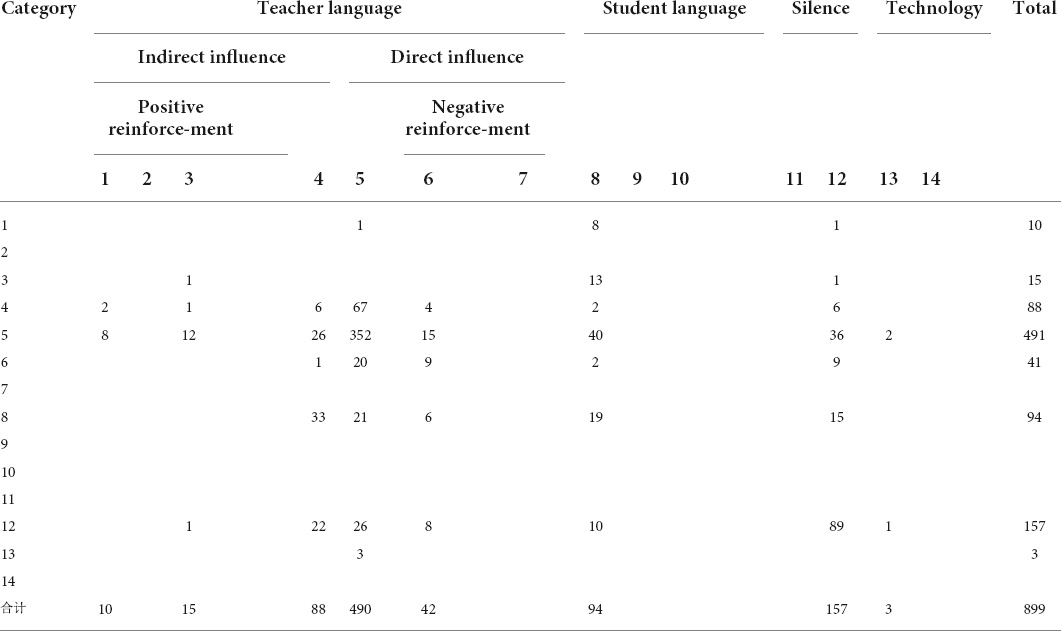
The improved Flanders interactive analysis system (iFIAS) matrix analysis of the student teacher’s (ST’s) mathematics classroom in lesson 1.
Appendix 3
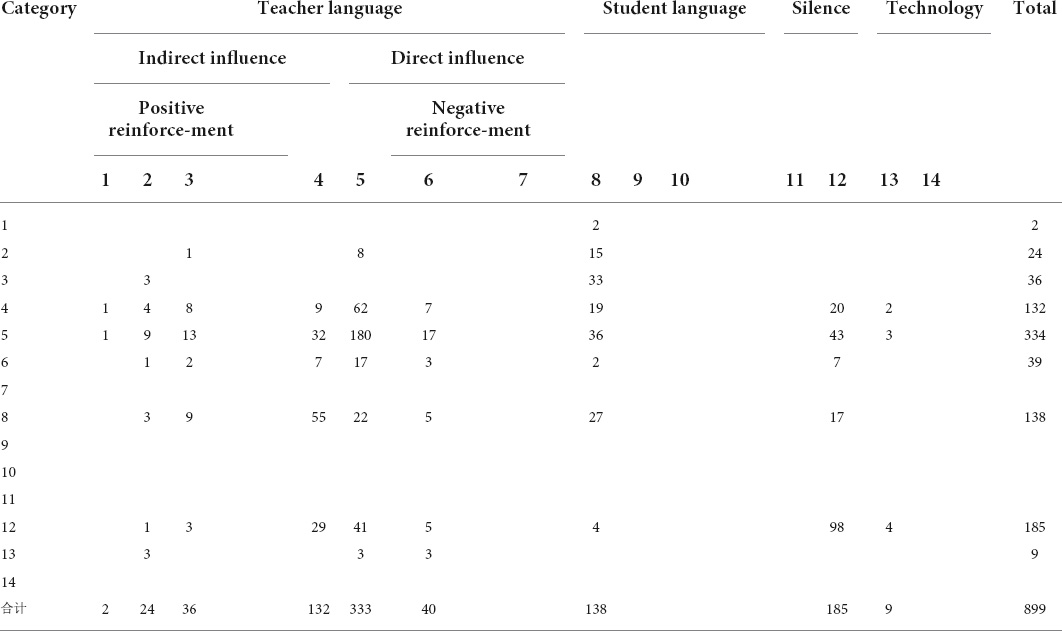
The improved Flanders interactive analysis system (iFIAS) matrix analysis of the student teacher’s (ST’s) mathematics classroom in lesson 2.
Appendix 4
Keywords: student teacher, mathematics classroom, interactive language, case study, guided self-reflection
Citation: Chen S, Liu H and Chen J (2022) Student teachers’ interactional language: Changes and improvements through guided self-reflection during the internship period. Front. Educ. 7:953888. doi: 10.3389/feduc.2022.953888
Received: 26 May 2022; Accepted: 16 August 2022;
Published: 13 October 2022.
Edited by:
Cheryl J. Craig, Texas A&M University, United StatesReviewed by:
Barry Bai, The Chinese University of Hong Kong, Hong Kong SAR, ChinaLaura Sara Agrati, University of Bergamo, Italy
Copyright © 2022 Chen, Liu and Chen. This is an open-access article distributed under the terms of the Creative Commons Attribution License (CC BY). The use, distribution or reproduction in other forums is permitted, provided the original author(s) and the copyright owner(s) are credited and that the original publication in this journal is cited, in accordance with accepted academic practice. No use, distribution or reproduction is permitted which does not comply with these terms.
*Correspondence: Huifang Liu, aHVpZmFuZ2xpdWdyYWNlQGdtYWlsLmNvbQ==
 Suanrong Chen
Suanrong Chen Huifang Liu
Huifang Liu Jie Chen3
Jie Chen3